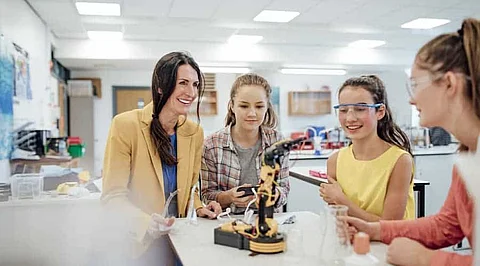

The classrooms in present era are not only expanding to use more technologies and digital tools but they are also engaging in machine learning
Technology in the classroom is becoming more and more popular as we pass through the 21st century. Laptops are replacing our textbooks, and on our smart phones, we can study just about everything we want. Social media has become ubiquitous, and the way we use technology has changed the way we live our lives fully.
Technology has become the core component of distance education programs. It enhances teachers and students to digitally interconnect and exchange material and student work, retaining a 'human link', which is important for the growth of young minds. Enhanced connections and customized experience can allow educators to recognize opportunities for learning skills and enhance the potential of a student.
Hence, the classrooms in present era are not only expanding to use more technologies and digital tools but they are also engaging in machine learning.
Machine learning is an artificial intelligence (AI) element, which lets machines or computers learn from all previous knowledge and make smart decisions. The architecture for machine learning involves gathering and storing a rich collection of information and turning it into a standardized knowledge base for various uses in different fields. Educators could save time in their non-classroom practices in the field of education by concentrating on machine learning.
For instance, teachers may use virtual helpers to work for their students directly from home. This form of assistance helps to boost the learning environment of students and can promote growth and educational success.
According to ODSC, "Last year's report by MarketWatch has revealed that Machine Learning in education will remain one of the top industries to drive investment, with the U.S. and China becoming the top key players by 2030. Major companies, like Google and IBM, are getting involved in making school education more progressive and innovative."
Analyzing all-round material
By making the content more up-to-date and applicable to an exact request, the use of machine learning in education aims to bring the online learning sector to a new stage. How? ML technologies evaluate the content of courses online and help to assess whether the quality of the knowledge presented meets the applicable criteria. On the other hand, know how users interpret the data and understand what is being explained. Users then obtain the data according to their particular preferences and expertise, and the overall learning experience increases dramatically.
Customized Learning
This is the greatest application of machine learning. It is adaptable and it takes care of individual needs. Students are able to guide their own learning through this education system. They can have their own speed and decide what to study and how to learn. They can select the topics they are interested in, the instructor they want to learn from, and what program they want to pursue, expectations and trends.
Effective Grading
In education, there is another application of machine learning that deals with grades and scoring. Since the learning skills of a large number of students are expressed in each online course, grading them becomes a challenge. ML technology makes the grading process a few seconds problem. In this context, we talk more about the exact sciences. There are places where teachers cannot be replaced by computers, but even in such situations, they can contribute to enhance current approaches of grading and evaluation.
According to TechXplore, "Researchers at University of Tübingen and Leibniz Institute für Wissensmedien in Germany, as well as University of Colorado Boulder, have recently investigated the potential of machine-learning techniques for assessing student engagement in the context of classroom research. More specifically, they devised a deep-neural-network-based architecture that can estimate student engagement by analyzing video footage collected in classroom environments.
They also mentioned that, "We used camera data collected during lessons to teach a deep-neural-network-based model to predict student engagement levels," Enkelejda Kasneci the leading HCI researcher in the multidisciplinary team that carried out the study, told TechXplore. "We trained our model on ground-truth data (e.g., expert ratings of students' level of engagement based on the videos recorded in the classroom). After this training, the model was able to predict, for instance, whether data obtained from a particular student at a particular point in time indicates high or low levels of engagement."
Join our WhatsApp Channel to get the latest news, exclusives and videos on WhatsApp
_____________
Disclaimer: Analytics Insight does not provide financial advice or guidance. Also note that the cryptocurrencies mentioned/listed on the website could potentially be scams, i.e. designed to induce you to invest financial resources that may be lost forever and not be recoverable once investments are made. You are responsible for conducting your own research (DYOR) before making any investments. Read more here.
